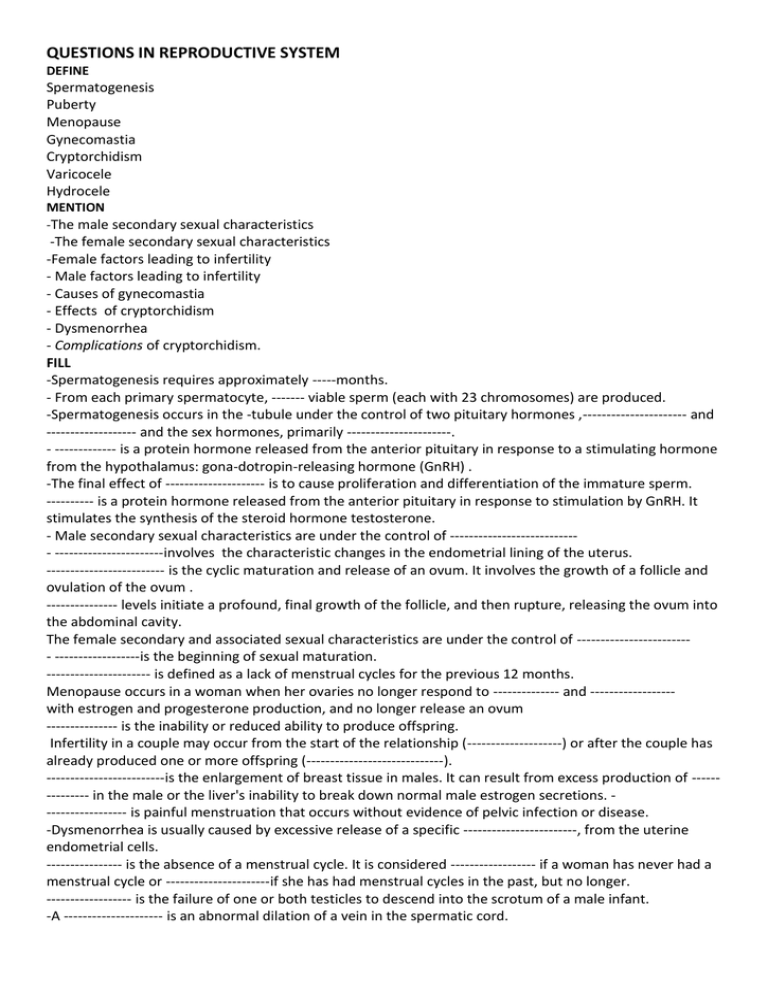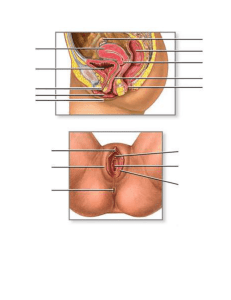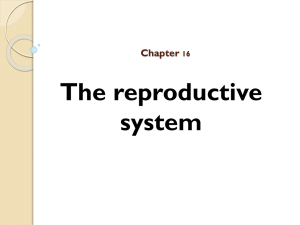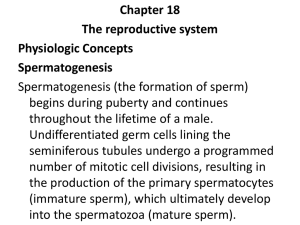questions in reproductive system
advertisement

QUESTIONS IN REPRODUCTIVE SYSTEM DEFINE Spermatogenesis Puberty Menopause Gynecomastia Cryptorchidism Varicocele Hydrocele MENTION -The male secondary sexual characteristics -The female secondary sexual characteristics -Female factors leading to infertility - Male factors leading to infertility - Causes of gynecomastia - Effects of cryptorchidism - Dysmenorrhea - Complications of cryptorchidism. FILL -Spermatogenesis requires approximately -----months. - From each primary spermatocyte, ------- viable sperm (each with 23 chromosomes) are produced. -Spermatogenesis occurs in the -tubule under the control of two pituitary hormones ,---------------------- and ------------------- and the sex hormones, primarily ----------------------. - ------------- is a protein hormone released from the anterior pituitary in response to a stimulating hormone from the hypothalamus: gona-dotropin-releasing hormone (GnRH) . -The final effect of --------------------- is to cause proliferation and differentiation of the immature sperm. ---------- is a protein hormone released from the anterior pituitary in response to stimulation by GnRH. It stimulates the synthesis of the steroid hormone testosterone. - Male secondary sexual characteristics are under the control of --------------------------- -----------------------involves the characteristic changes in the endometrial lining of the uterus. ------------------------- is the cyclic maturation and release of an ovum. It involves the growth of a follicle and ovulation of the ovum . --------------- levels initiate a profound, final growth of the follicle, and then rupture, releasing the ovum into the abdominal cavity. The female secondary and associated sexual characteristics are under the control of ------------------------ ------------------is the beginning of sexual maturation. ---------------------- is defined as a lack of menstrual cycles for the previous 12 months. Menopause occurs in a woman when her ovaries no longer respond to -------------- and -----------------with estrogen and progesterone production, and no longer release an ovum --------------- is the inability or reduced ability to produce offspring. Infertility in a couple may occur from the start of the relationship (--------------------) or after the couple has already produced one or more offspring (-----------------------------). -------------------------is the enlargement of breast tissue in males. It can result from excess production of -------------- in the male or the liver's inability to break down normal male estrogen secretions. ----------------- is painful menstruation that occurs without evidence of pelvic infection or disease. -Dysmenorrhea is usually caused by excessive release of a specific ------------------------, from the uterine endometrial cells. ---------------- is the absence of a menstrual cycle. It is considered ------------------ if a woman has never had a menstrual cycle or ----------------------if she has had menstrual cycles in the past, but no longer. ------------------ is the failure of one or both testicles to descend into the scrotum of a male infant. -A --------------------- is an abnormal dilation of a vein in the spermatic cord. -A ----------------------------is the collection of a plasma filtrate in the scrotum, outside the testes. This filtrate results in scrotal swelling and can reduce blood flow to the testes. A hydrocele may be a congenital problem or may be caused by trauma to the genitals. A testicular tumor may cause formation of a hydrocele. Idiopathic development may also occur. ------------------------- is the non-cancerous enlargement of the prostate gland. ----------------------------- is the infectious inflammation of any of the organs of the upper genital tract in women, including the uterus, fallopian tubes (salpingitis), or ovaries (oophoritis). -In an ----------------------------------, the embryo implants and grows at a site other than the uterus, usually the fallopian tube. ---------------------------- is the presence of uterine endometrial cells outside the uterus, anywhere in the pelvic or abdominal region. -The endometrial cells respond to estrogen and progesterone with proliferation, secretion, and bleeding during the menstrual cycle. ---------------------, a radiograph of the breast, is an important screening tool to identify breast cancer before a lump can be felt. TRUE OR FALSE -Spermatogenesis (the formation of sperm) begins during puberty and continues throughout the lifetime of a male. -Spermatogenesis requires approximately 2 months. -From each primary spermatocyte, four viable sperm (each with 23 chromosomes) are produced. -FSH is a protein hormone released from the anterior pituitary in response to a stimulating hormone from the hypothalamus: gona-dotropin-releasing hormone (GnRH) . -The final effect of FSH is to cause proliferation and differentiation of the immature sperm. - LH is a protein hormone released from the anterior pituitary in response to stimulation by GnRH. -LH stimulates the synthesis of the steroid hormone testosterone. - Changes in the secretion of GnRH may affect sperm formation by affecting LH and FSH and may alter libido. -Male secondary sexual characteristics are under the control of the male androgens, especially testosterone. -Increased amounts of sebum can cause acne, especially during teenage years. -A deepening voice, in males result of hypertrophy of the larynx. -LH levels initiate a profound, final growth of the follicle, and then rupture, releasing the ovum into the abdominal cavity. -The female secondary and associated sexual characteristics are under the control of estrogen - Optimal fertility in women lasts to about 30 years of age and then begins to fall sharply with increasing frequency as a woman ages. – -Immune responses may destroy the implanted embryo if the woman is either hyperimmune to the embryo or fails to develop tolerance to it. -Male factors causing deformed sperm or sperm too few in number. - Male infertility may occur following infection and scarring of the testicles, epididymis, vas deferens, or urethra. - Systemic infections, such as mumps, may cause swelling of the testicles and destruction of the seminiferous tubules. - Obstruction of the blood vessels supplying the testes can cause hypoxia and a failure of the sperm to develop or survive. - Autoantibodies produced against sperm may reduce sperm number and quality. - Exposure of the testicles to high temperature may reduce spermatogenesis. -Gynecomastia is frequently seen during early puberty in some males and may be a normal development or may be related to excess body weight or a hormonal imbalance. - Dysmenorrhea is usually caused by excessive release of a specific prostaglandin, from the uterine endometrial cells. - For most women, non-steroidal anti-inflammatory drugs (NSAIDs) that inhibit prostaglandin production, such as ibuprofen, can effectively reduce cramping. -Prostaglandin inhibitors should be used at the first sign of pain or at the first sign of menstrual flow. - Because forceful menstrual cramping may contribute to the development of endometriosis (painful growth of uterine tissue outside of the uterus). -Complaints of dysmenorrhea should always be taken seriously, and attempts should be made to reduce its incidence. -Emotional disturbances and physical stress may also cause amenorrhea. -Endocrine disorders, especially involving the ovaries, pituitary, thyroid, or adrenal glands, can cause amenorrhea, both primary and secondary. - Cryptorchidism is present at birth and is especially common in premature infants. -For most infants born with this condition, the testes will descend on their own within the first year of birth. -If descent does not occur, the testes will remain at a higher temperature than optimal for spermatogenesis. -Cryptorchidism may affect sperm quantity and quality, leading to infertility later in life. -Male sexual function and secondary sexual characteristics are normal in Cryptorchidism. - Most cases of cryptorchidism will reverse spontaneously within 1 year. -If spontaneous descent does not occur, treatment with hCG may stimulate descent. -If hormonal therapy is ineffective, surgery is required and should be performed by 2 years of age. -A varicocele is an abnormal dilation of a vein in the spermatic cord. -A sudden occurrence of a varicocele in an older man may indicate an advanced renal tumor. -A varicocele may lead to Poor blood flow to the testes and may cause infertility. -A hydrocele may be a congenital problem or may be caused by trauma to the genitals. -A testicular tumor may cause formation of a hydrocele. -A hydrocele can reduce blood flow to the testes. -BPH is seen in more than 50% of men older than 60 years of age. - The cause of BPH is unclear but may be related to an imbalance between estrogen and testosterone in the prostate. -With advanced BPH, urinary tract obstruction may lead to urinary tract infections and, if unrelieved, renal failure. - Epididymitis and orchitis may cause infertility -The infectious agent of PID is usually bacterial and is often acquired during sexual intercourse. - PID may lead to scarring and adhesions of the uterus or fallopian tubes, predisposing a woman to infertility. - Rupture of the fallopian tube with ectopic pregnancy may occur, leading to internal hemorrhage and maternal death. - Approximately 5% to 10% of women with PID die, usually from septic shock. - The endometrial cells respond to estrogen and progesterone with proliferation, secretion, and bleeding during the menstrual cycle. This can cause inflammation and severe pain. - The inflammation of the endometrial cells may lead to scarring of pelvic or abdominal organs and infertility - Cervical cancer is often a result of a sexually transmitted disease of the cervix caused by certain strains of the human papillomavirus (HPV). - Cervical cancer is most common in women who have had multiple sexual partners. -The premalignant changes, called dysplasia, can be identified and staged during cytologic studies of a cervical smear (the Papanicolaou smear, or Pap smear). Endometrial cancer is related to lifetime exposure to estrogen and typically presents in postmenopausal women. - Protection against breast cancer is possible by consumption of a diet rich in fruits and vegetables, regular exercise, and weight control. -Breast self-examination (BSE) performed on a regular (monthly) basis is important for early detection of a tumor. -BSE should be performed by all women older than 20 years. -Mammography, a radiograph of the breast, is an important screening tool to identify breast cancer before a lump can be felt. -Annual or biannual mammography is recommended for all women older than 40 years of age and for younger women with a family history of the disease or other risk factors. MCQ *The male secondary sexual characteristics include the following: a- Increased protein anabolism and muscle mass. b-Increased bone growth and strength. c-Male pattern of hair on the face, axillary, and pubic regions. Hair growth is thick on most areas of the body. d-Proliferation and activation of sebaceous glands in the skin, which produce an oily substance called sebum. Increased amounts of sebum can cause acne, especially during teenage years. e-A deepening voice, as a result of hypertrophy of the larynx. f- all *Miscarriages later in gestation may occur if a-the placenta is poorly placed b- if placenta is poorly perfused with blood c- if the cervix cannot support the weight of a growing fetus. D- all *Male factors causing infertility may include a- Systemic infections, such as mumps, may cause swelling of the testicles and destruction of the seminiferous tubules. b- Obstruction of the blood vessels supplying the testes can cause hypoxia and a failure of the sperm to develop or survive. c-Autoantibodies produced against sperm may reduce sperm number and quality. d-Exposure of the testicles to high temperature may reduce spermatogenesis. * Amenorrhea exists naturally a-before puberty (primary amenorrhea) b-after menopause (secondary amenorrhea). c- during pregnancy d- during lactation. e- all * A hydrocele may be a-a congenital problem b- caused by trauma to the genitals. c- caused by testicular tumor d- all *BPH may cause a-compression of the urethra as it passes through the prostate, making urination difficult, b-reducing force of the flow of the urine stream. c- dribbling of urine to occur. d- all * Clinical Manifestations of BPH may include a-Increased frequency of urination b- a reduction in the force of the urine stream. d-dribbling or urine overflow. e-The time required to void increases. F- all * Risk Factors for Breast Cancer include a- a history of the disease in one or more first-degree relatives (sisters or mother). b- Lifetime estrogen exposure , as early menarche and late menopause c- Lack of or delayed childbearing d- Hormone replacement therapy (HRT) in postmenopausal women appears to increase the risk of breast cancer.









